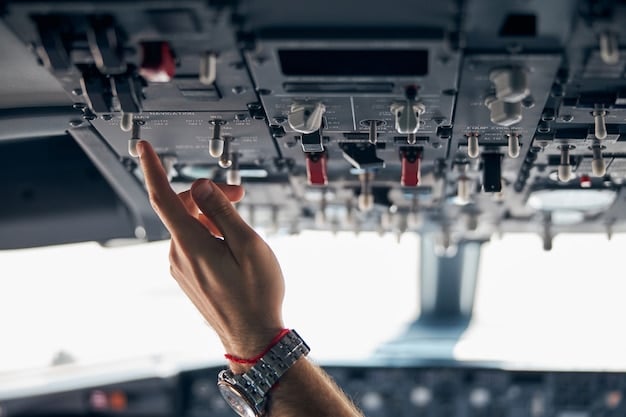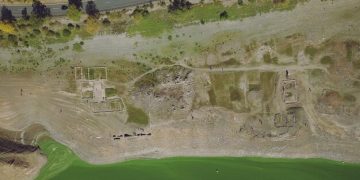Analyzing Cybersecurity Vulnerabilities in Modern Military Aircraft

Analyzing the Cybersecurity Vulnerabilities of Modern Military Aircraft Systems is crucial for national security, as these sophisticated machines become increasingly reliant on interconnected digital networks, presenting numerous exploitable weaknesses.
Modern military aircraft systems represent a pinnacle of engineering and technological achievement. However, their increasing reliance on digital networks and complex software also introduces significant cybersecurity risks. **Analyzing the Cybersecurity Vulnerabilities of Modern Military Aircraft Systems** is paramount to ensuring their operational effectiveness and protecting sensitive data.
Understanding Cybersecurity in Military Aircraft
The integration of advanced digital technologies in modern military aircraft has revolutionized warfare. However, this dependence also creates potential vulnerabilities that adversaries could exploit. A comprehensive approach to Analyzing the Cybersecurity Vulnerabilities of Modern Military Aircraft Systems is essential for mitigating these risks.
The Evolution of Aircraft Systems and Cybersecurity
Modern military aircraft rely on complex systems integrating avionics, communication, radar, and electronic warfare capabilities. Understanding how these systems evolved is crucial to comprehending current cybersecurity challenges.
- The integration of networked systems has increased exponentially over the past few decades.
- This evolution has led to vulnerabilities not previously considered in older, more analog systems.
- The complexity of modern aircraft systems requires constant vigilance and adaptation to new threats.
To effectively protect military aircraft systems, it is necessary to understand their increasingly complex digital nature. This approach requires a deep dive into both legacy systems and new tech integrations with an eye to discovering flaws as they appear.

Key Vulnerability Areas in Aircraft Systems
Modern military aircraft systems are vulnerable to a wide array of cyber threats. These vulnerabilities exist across various components– from the aircraft’s software to communication networks and hardware. A robust security posture must address each of these points of risk.
Software and Firmware Vulnerabilities
Aircraft software and firmware can contain bugs, design flaws, or vulnerabilities that malicious actors can exploit. These vulnerabilities could lead to unauthorized control of aircraft systems.
Regular security audits are essential for mitigating these risks. Performing vulnerability scanning and penetration testing can help discover and fix software and firmware flaws.
Communication Systems and Network Security
Communication systems are another significant area of concern. Modern military aircraft rely on a variety of communication networks for command and control. Securing these networks is of great importance. Any sort of compromise to the network could result in loss of sensitive data or disruption of critical operations.
Implementing strong encryption protocols, intrusion detection systems, and secure authentication mechanisms is essential. You can significantly reduce the risk of your aircraft system being compromised by implementing these security measures.
Assessing and Mitigating Cybersecurity Threats
A comprehensive approach to Analyzing the Cybersecurity Vulnerabilities of Modern Military Aircraft Systems requires not only identifying vulnerabilities but also implementing suitable strategies and measures. These strategies should be in line with the aircraft’s particular risk environment.
Risk Management and Threat Modeling
Risk management involves identifying, assessing, and prioritizing risks. Threat modeling identifies potential threats. This helps address them. By thinking like an attacker, it is possible to uncover likely vectors of cybercrime.
- Conducting regular risk assessments is crucial for ensuring that security measures remain effective.
- Threat modeling should be an ongoing process, adapting to new and emerging threats.
- Combining risk management with threat modeling provides a holistic view of the cybersecurity landscape.
Consider using standards like NIST Cybersecurity Framework to improve your risk management strategies. Consider standards like OWASP’s to enhance the rigor of your threat modeling.

The Role of Emerging Technologies
Emerging technologies can improve cybersecurity in modern military aircraft systems. By leveraging AI and machine-learning, we can anticipate and mitigate potential cyberthreats.
Artificial Intelligence and Machine Learning
AI and machine learning can enhance threat detection, incident response, and predictive maintenance. These things can make an aircraft more ready for operations, and less subject to unexpected events.
These technologies offer significant potential for enhancing aircraft security. By studying data patterns, AI models can detect anomalies. This allows the aircraft to prevent things like malware from infecting important flight systems.
Blockchain Technology
Blockchain technology offers possibilities for secure data storage and transfer, enhancing the integrity of critical information. This promotes accountability in the event of potential data breaches.
Blockchain also enhances transparency and lowers the risk of data tampering. By using a decentralized ledger, blockchain technology helps make sure critical information is secure and verifiable.
International Standards and Compliance
Compliance with certain international standards and regulations is essential. It has a direct impact on maintaining the security and reliability of modern military aircraft systems.
Importance of Compliance and Standardization
Compliance with international standards ensures interoperability. It also provides a baseline for cybersecurity practices. Standardization improves the overall security posture of military aircraft industries.
- Adhering to standards ensures compatibility across different systems and platforms.
- Compliance helps in maintaining a consistent level of security across the industry.
- Standardization promotes best practices and enhances the resilience of systems.
Complying with international standards not only enhances security. It helps ensure the interoperability of aircraft systems across different platforms world-wide.
| Key Aspect | Brief Description |
|---|---|
| 🛡️ Risk Management | Vital for identifying, assessing, and mitigating risks in aircraft cybersecurity. |
| 🌐 Network Security | Securing communication and data transmission is crucial in networked systems. |
| 🤖 AI Integration | Using AI to automatically find threats and respond faster. |
Frequently Asked Questions
It is essential for maintaining national security. Analyzing these vulnerabilities helps protect against potential cyberattacks that could compromise operational effectiveness and sensitive data.
Main vulnerabilities include software flaws, network insecurities, and hardware vulnerabilities. Communication systems and data transmission methods can also be potential targets.
AI enhances threat detection by spotting anomalies and improving incident response. It helps to automate security measures and predict potential vulnerabilities. The goal should be automating as much of the cyber security as possible.
Threat modeling identifies potential threats by thinking like an attacker. It helps create countermeasures that mitigate these threats before the bad actors can exploit a particular vector of cyberattack.
Manufacturers should comply with standards such as NIST Cybersecurity Framework and relevant ISO standards. This helps to ensure consistency and interoperability with security practices globally.
Conclusion
In conclusion, Analyzing the Cybersecurity Vulnerabilities of Modern Military Aircraft Systems is vital for maintaining operational effectiveness. By identifying and mitigating vulnerabilities, integrating modern technologies, and following international standards, it becomes possible to improve protection against cyber attacks.





